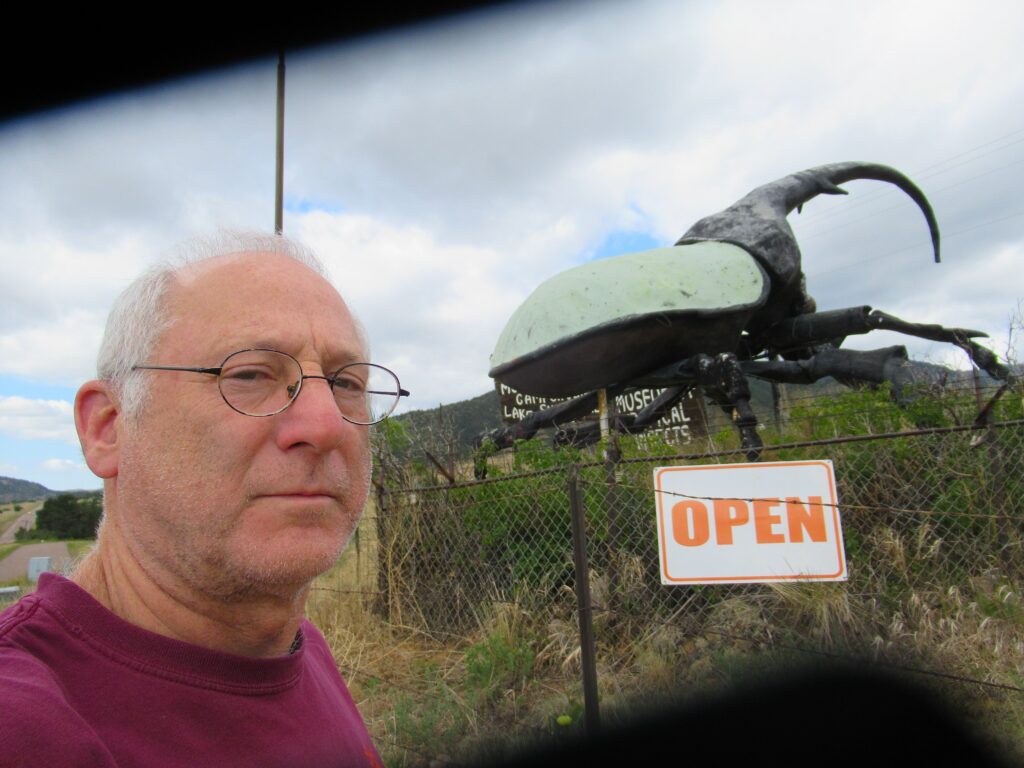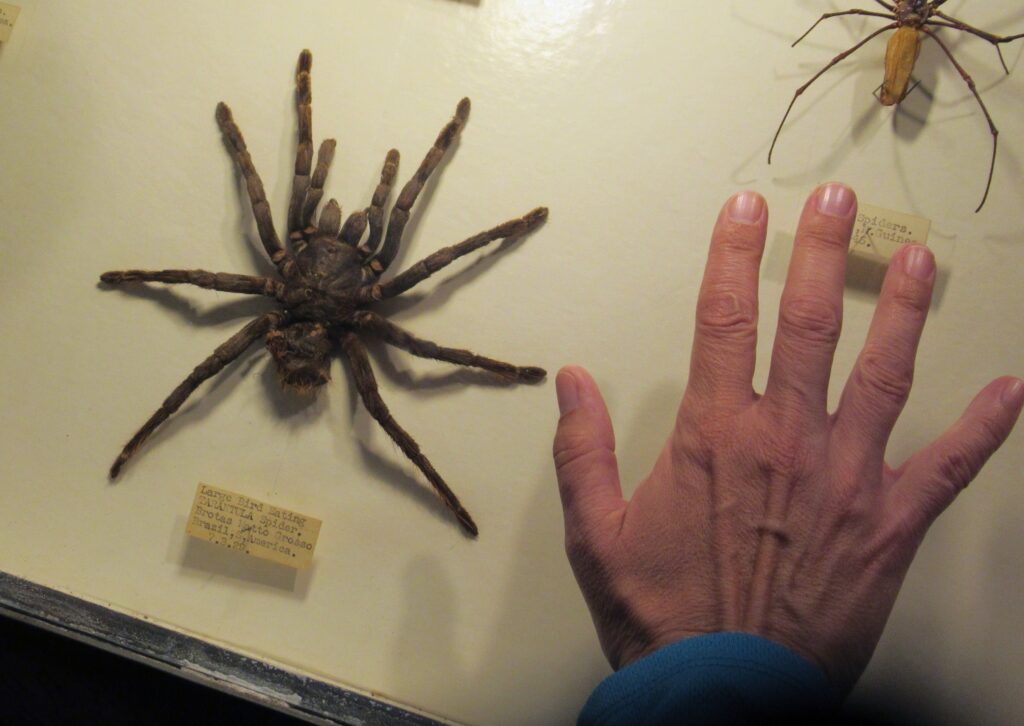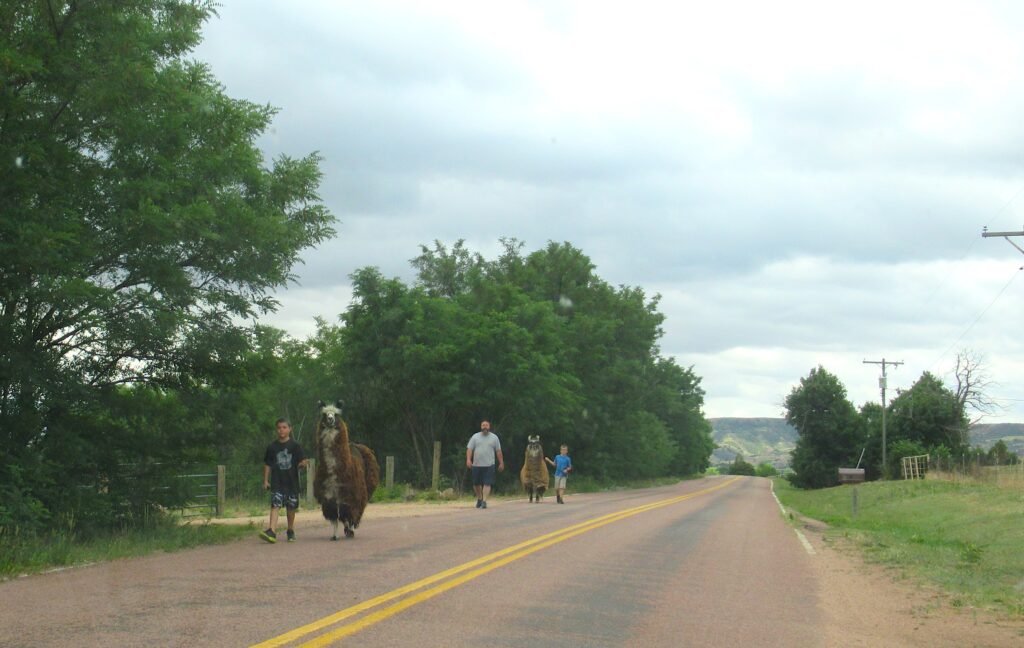Colorado Springs
Colorado
June 2018
The world’s largest beetle.
The world’s largest beetle is bigger than your pancreas. That is a very large beetle, an Oh-My-God! sized critter. It’s called Titanus giganteus, or the Titan beetle. I’ve been told that the Titan beetle is strong enough to snap a pencil (why it would do that is still being researched,) it can rip your flesh off if it has a mind to and it can knock a bicyclist right off the bike. If Titanus giganteus is hissing, run away!
This beetle lives only in the Amazon rain forest, so if your next vacation is in northwestern Brazil, watch your ass. And your pencil.
As I say, we’re visiting the world’s largest beetle but admittedly, it is actually not the Titanus giganteus. No, it’s bigger. It is a West Indian Hercules beetle, also categorized in the Oh-My-God! department of size evaluation. Our big scary beetle is in a field near a highway intersection, in the same place it has stood for more than 50 years. This one is made of metal and it is placed in this location to tip you off that something is happening back in the woods there.

We pull off the main road into a convenient parking lot. As I exit the car to take photographs, Lisa quickly notices that the ground beneath our feet is moving. Crawling, in fact. Oh, it’s not the ground. It’s ants. Hundreds, nay, thousands of frantic, red ass ants. I think they may be fire ants, but fire ants don’t live in Colorado. Could they be red harvester ants? I hope not; their bite is vicious. But they are unlikely roaming around this time of year. Formica oreas? Maybe, but I can’t give positive I D. C’mon, I’m not a myrmecologist. How would I know? Lisa quickly climbs back into the car.
I will call them Red Ass Ants, quickly take my photographs and also climb back into the car.
A little more about this giant metal beetle. His name is Herkimer and he was built in the 1950s and placed here to call attention to the May Natural History Museum, which is what is tucked back in the woods there.
Take a side trip with me for a moment. Weeki Wachee Springs State Park in Florida features live mermaid shows. Come see Stayce and Amanda and Katie and Sami and Kristy hold their breath for a ridiculously long length of time while they do their mermaidy stuff underwater.
You can send them “Tail mail.”
Some time ago, the May family, who owns and runs the natural history museum here in Colorado, decided to move, along with the gigantic Hercules beetle, to this mermaid heaven in Weeki Wachee Springs. How the name wasn’t a caution to them is not documented.
The first problem they encountered was the humidity. Four of the top ten most humid cities in the country are in Florida. Great for Homo pisces (mermaids) but less than ideal for big wooden boxes full of dead insects who, upon exposure to such moisture laden air, rapidly begin to decompose.
The second problem with this location had to do with the nature of public attractions. The king of all public attractions, Walt Disney, took a liking to the bug museum and made an offer to buy the whole collection. James May, founder of the museum, was willing to sign on the bottom line with one condition; his father’s name was to be forever associated with the collection. Disney said nope. James May said no deal.
Then, MGM Studios purchased the Weeki Wachee Springs resort. They gave the Mays an option; sell the exhibit to them or leave. That was that. The Mays loaded up their boxes of bugs and drove back to Colorado with Herkimer on a flatbed truck.
In contrast, Colorado Springs is one of the driest cities in the country. Lynda Senko, who currently runs the museum, says, “[Our specimens] probably could last forever as long as we keep them dry.”
For all these reasons, the museum is now in its perfect place, in the middle of Colorado. And so is Herkimer, at the highway intersection, alerting curious motorists that there are more things in heaven and Earth than just a big bug. There are lots of big bugs.
From the giant Hercules beetle Herkimer’s hunkering spot on Colorado Highway 115, we drive west just shy of a mile on Rock Creek Canyon Road and park back there in the woods at the May Natural History Museum. This is also where you park to register for the May Museum Golden Eagle Ranch RV Park, a campground.
Lisa and I pay our entry fee to the museum and see many bugs stuck on insect pins. They are from all over the world including the creatures that were found right here in Colorado Springs, probably right here in the campground, probably the ones with the largest teeth.
We wander through the cases of beasties, forgoing the twenty-minute movie about the family. We are interested, but something about being on vacation in Colorado doesn’t feel right to sit down and watch a movie.
One of the first things we notice is the quiet. Just some old-fashioned quiet. There are no electronic displays, no touch-screen exhibits, no smartphone tours, no soundtracks. The most sophisticated device we see is a magnifying glass. The display cases are lit by handmade, gooseneck incandescent light fixtures. The owners like the feel that the museum itself is a preserved specimen, with hand-lettered ID labels accompanying the specimens. Nothing, other than some of the brightly reflective insects, is slick.

We walk through, staring at all the bugs under glass. “Look at that!” “Look at this one!” This was pretty much our dialog for the next hour or so. Unreal giant tropical insects and spiders, prismatically glowing colored butterflies, dragonflies and hairy moths.
Foot-long millipedes, bird-eating spiders, creepy crawlies as big as your hand, beetles so massive that they “can break street lights and knock a man down if they hit him while flying,” deadly scorpions (you could die just by looking at them!) and some critters that completely stump us.

Tarantula the size of your morning bagel with everything, stick insects you could use as walking poles and tsetse flies, some with violins.
Curiously, the display case that labels a black widow spider is empty. Lynda Senko explains that they let this one go at the end of the season. It’s easy, she tells us, to catch a new one when they need it.
Um…
Just about every bug here could convince you never to go into the woods again.
There are 7000 bugs on display. They say that some are more than 100 years old. “There is a sincerity to this museum; it’s the real thing,” says R J Steer, James’ great grandson and the museum’s current president. “It’s not a hobbyist’s collection — it’s a naturalist’s collection, and it has a scientific value that is indeterminably large. We have specimens that are thought to be extinct, specimens that are illegal to collect because they’re endangered and specimens that nobody’s seen since.”
Back around the time of Charles Darwin, early-mid 19th century, there was a guy who was a collector for the British Museum. This guy, John May, took his family to Brazil where they came upon a jungle full of species that surprised and shocked them, bugs no European eyes had ever seen before.
Then John died of malaria. His son, the previously mentioned James, traveled to Africa and promptly sustained a critical injury. Fortunately he was nursed back to health by a local band of friendly Zulus. During his convalescence, he continued his father’s work by collecting exotic species of tropical insects.
James continued to collect and trade insects throughout all the inhabited continents, eventually leading to what has been called the most extensive collection of insects in the world.
James had three sons. His firstborn, John, had a head for business. He made airtight wooden cases and meticulously preserved, mounted and scientifically labeled thousands of specimens. He procured a truck trailer and drove the bugs around to flower shows, auto shows, state fairs and expositions. People loved the exhibit!
In their travels, the Mays — it had become a family business by now — had noted that the foothills of the eastern Rockies are an unlikely place to find jungle bugs, but it was sort of centrally located and it had that low humidity. Also, very few native insects, like termites, would eat the bugs or the wooden cases in which they were displayed.
Then they did that whole Weeki Wachee thing. Coming to their senses, they are now back here, on land purchased in the mid-20th century by Vicky May, R J Steer’s grandmother.
Lisa asks me how they actually trap the bugs. Harkening back to my high school biology class where one of our assignments was to build an insect collection, I tell her, “When I collected, I would put on a pair of worn out pants and tie them at the ankles. I dressed in a baggy long sleeve shirt, a hat and a bug net over my head. Then I would awkwardly run around an overgrown field swinging my very soft insect net at them. Can you say “doofus?” (It has been noted that Hymenoptera are, as a rule, better dressed than Entomologists.)
My prize specimen was a rainbow stag beetle, Phalacrognathus muelleri.
After our visit, we are surprised to find that James and John May would often shoot down giant flying insects using a gun loaded with sand.
Just a few more tidbits.
– If the bugs don’t get you, or the mermaids, just two minutes up the road from Herkimer is the Pet Rest Memorial Park. Hopefully these dead pets are not displayed in wooden boxes with pins through their chests.
– Speaking about death, the museum houses 100 000 specimens. That’s a lot of killing. Takes a certain kind of person. And a lot of sand.
– An entirely different man named John May was a member of the Bugs Moran crime gang. He died in the Saint Valentine’s Day Massacre in Chicago, back in 1929. Bugs Moran, eh?
– Driving away from the bug museum, we spy a couple of kids walking their llamas. Outside the bug museum, what else would they be walking?

And finally, if you are concerned with the imagined danger posed by close physical proximity with all these bugs, please go to my column titled Ouch to better understand just how much pain they can inflict.
